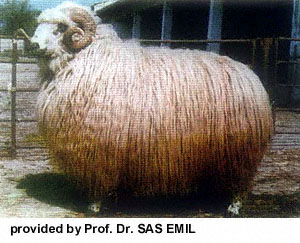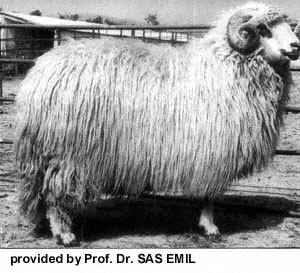Tsurcana Sheep
 The Tsurcana may have descended from the wild Ovis vignei arkar. Since prehistoric
times it has been domesticated in the Carpathians Mountains where it was established
as a breed. It spread with the movement of flocks through the Alpine grazing areas
to all Central European countries. The Tsurcana and its varieties are widely spread
over Romania. Known as Valachian Zeckel it can also be found in southern Ukraine, Moldova (Tushka), Greece, Albania, Yugoslavia, Croatia, Bosnia-Hertzegovina, Slovenia, Czech Republic, Slovakia and Poland. The greatest density of population, over six million, are found in Romania, mostly
in mountainous regions. There are three varieties: white, gray and black. The white
Tsurcana is the most numerous and highly selected, presenting specific ecotypes for
the breeding areas Sibiu-Alba, Hunedoara, Vaideeni-Novatchi, Vrantchea, Câmpulung
Muschel, Caransebesh. From the precocity point of view, there are two types: precocious
tsurcana and belated tsurcana. The tsurcana breed has increased from 40% to 60% of
the total sheep population in Romania during the 1990's.
The Tsurcana may have descended from the wild Ovis vignei arkar. Since prehistoric
times it has been domesticated in the Carpathians Mountains where it was established
as a breed. It spread with the movement of flocks through the Alpine grazing areas
to all Central European countries. The Tsurcana and its varieties are widely spread
over Romania. Known as Valachian Zeckel it can also be found in southern Ukraine, Moldova (Tushka), Greece, Albania, Yugoslavia, Croatia, Bosnia-Hertzegovina, Slovenia, Czech Republic, Slovakia and Poland. The greatest density of population, over six million, are found in Romania, mostly
in mountainous regions. There are three varieties: white, gray and black. The white
Tsurcana is the most numerous and highly selected, presenting specific ecotypes for
the breeding areas Sibiu-Alba, Hunedoara, Vaideeni-Novatchi, Vrantchea, Câmpulung
Muschel, Caransebesh. From the precocity point of view, there are two types: precocious
tsurcana and belated tsurcana. The tsurcana breed has increased from 40% to 60% of
the total sheep population in Romania during the 1990's.
Exterior Traits
 Average height, long-limbed and medium-limbed, at maturity the ram weight averages
60-80 kg and the ewe weight 40-55 kg. The Tsurcana exhibits a narrow, straight head.
The rams are horned as are 50% of the ewes. The color can be white, brownish-black
or gray, depending on the variety. In white sheep there are frequently spots around
the lips, eyes and on the face and limbs. The trunk is medium; the well-developed
barrel allows the attachment of a globe-shaped and well-developed udder. The breed
is easily recognized by its coarse rough wool with a staple length of 20-30 cm. This
breed has a harmonious body, a lively temperament, very quick in searching food. During
mild winters it can be feed on the pasture only.
Average height, long-limbed and medium-limbed, at maturity the ram weight averages
60-80 kg and the ewe weight 40-55 kg. The Tsurcana exhibits a narrow, straight head.
The rams are horned as are 50% of the ewes. The color can be white, brownish-black
or gray, depending on the variety. In white sheep there are frequently spots around
the lips, eyes and on the face and limbs. The trunk is medium; the well-developed
barrel allows the attachment of a globe-shaped and well-developed udder. The breed
is easily recognized by its coarse rough wool with a staple length of 20-30 cm. This
breed has a harmonious body, a lively temperament, very quick in searching food. During
mild winters it can be feed on the pasture only.
Environmental Adaptability
Tsurcana is highly adapted to mountainous conditions but it also spreading well received in hill and plains areas.
It is a hardy breed, remarkably well adapted to bad weather due to its highly water resistant fleece and ability to cover long distances in search of forage. The breed is also very disease resistant. In autumn it develops 5-10 kg of internal fatty deposits, which is used as energy supplies during the winter and dry-lot period. The winter feeding costs are typically 2-3 times less in comparison with the finewool breeds.
Productive Traits
It is a dual-purpose breed raised for milk, meat and wool production (Sibiu, Brashov, Caransebesh, Alba, Hunedoara, Gordge); milk, fur of young lambs and wool (Moldavia) depending on ecotype and the breeder's specialty.
Milk
Medium production for primiparas 100 ± 40 kg and for pluriparas 150 ± 50 kg is obtained in 220 lactation days. The fat percentage is 7-8% and 6% in protein in milk. The milk is very good for feta, yogurt, Swiss cheese, cheese for pizza.
Meat
Newborn lambs weigh 3-4 kg and then their weight increases as follows: 9-10 kg (30 days old lambs), 20-25 kg (90 days old lambs), 30 kg (150 days old lambs). Suckling lambs with supplemental feeding from the age of ten days reach 15-17 kg at 45 days, gaining 150-275 g daily. If best conditions are provided, weaned lambs at 2.5-3 months and fattened intensively reach 40-47 kg at the age of 7 months.
Wool
2-4 kg in ewes, 4-6 kg in rams, the wool strand has long and thick fibers (is 25 cm, 50-100 µ respectively), intermediate (12-15 cm and 35-45 µ respectively) short ones (9 cm, 25 - 35 µ respectively). It is used for oriental carpets.
Fur of young lambs: the black and gray varieties are good for cross-breeding, with Karakul breed, having as a result 70-80% good quality Karakul fur.
Reproductive Traits
- Fertility - 90-95%
- Prolificacy - precocious tsurcana 120-140%
- Belated tsurcana 103-105%
- In some flocks, 40% from the whole amount have no lactation anoestrus, thus they can be mated starting from July and their parturition being at the beginning of December.
European Breeds Related
- Germany and Austria
- Grane Gehörnte Heidschnucke
- Skudde
- Tiroler Steinschaf
- Spain
- Chura
- Poland
- Wrzosowka
- Italy
- England
Improving Activities
- Ecotype selection aiming
- to improve the milk production and the milkability.
- to improve daily gain over 300 g.
- Genetic evaluation of sires can be done using BLUP-ANIMAL MODEL method.
- Animal modeling hybridization:
- for milk improving
- not usual in mountains area
- Friza x Tsurcana in hills area;
- Awassi x Tsurcana at the plains;
- for mutton improving:
- Drysdale x Tsurcana;
- Lincoln x Tsurcana.
- for milk improving
The Tsurcana hybrids with varieties specialized for milk or mutton are more productive, but less resistant at the environment and consequently most breeders prefer purebred animals. Generally speaking, Tsurcana sheep are beautiful, harmonious, resistant, good for moving to/from Alpine pastures, less expensive, good for milk, mutton, wool and fur of young lambs. As a result, this breed is more and more preferred by breeders.
References
Prof. Emil Sas & Asst. Ioan Hutu- Romania
